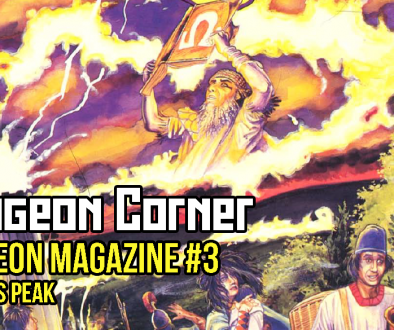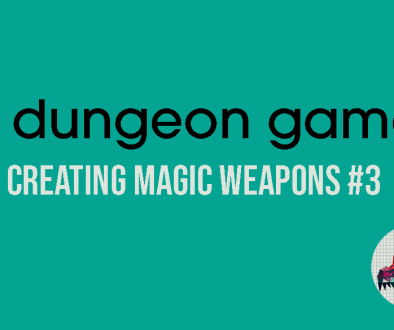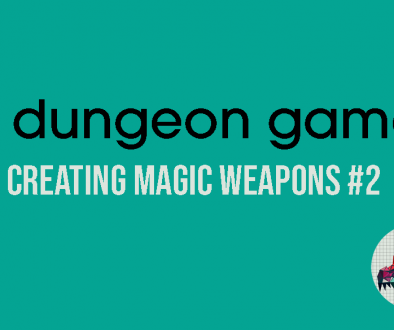Strength In Adventure Games
This was originally a Twitter thread posted in July 2021. I’ve wanted to move it onto the blog for a while now anyway, but the impending explosion of the bird site finally gave me the kick I needed to actually do it.
Unlike my other thread mirrors (like the long reads that I do) I’ve cleaned this up and added to it a little. For as long as Twitter is still functional, you can read the original thread here.
Edit 11/09/2023: The ideas in this article form a core part of A Dungeon Game, my light dungeon crawler that’s available for free online here or which you can purchase here. The first adventure for this game, The Moss Mother’s Maze, is now available in print here or digitally here. The header image from this post also contains artwork produced by MidJourney, which I was using for this purpose when the first versions were released and before I had fully grasped the many valid ethical concerns about how these images are generated. I no longer use this sort of generative imagery in my work, and I regret having done so in the past.
A lot of dungeon games that centre violence and fighting are very concerned with representing physical strength. There are ways of working out how much you can carry, what you can press overhead, whether you can bend bars or loft gates, etc. But one thing I can’t remember seeing is accounting for waning strength with exertion.
For those who are unaware, my biggest hobby outside of RPGs is strength training. I particularly love deadlifting heavy. I know that when I’m warmed up and fresh – i.e. I haven’t done any working sets yet – I can lift somewhere around 170kg and hold it for a decent amount of time. And if we shorten the range of motion to something like a rack pull, I can lift around 220kg. At the time I originally wrote this thread those numbers were lower – and while strength gains as a consequence of exertion isn’t something I want to talk about it this post, it’s something worth keeping in mind for any system that attempts to actually simulate strength.
Deadlifting weight off the floor doesn’t seem hugely relevant to games, but it suddenly becomes relevant if we pretend it’s a portcullis that you’re crawling under, or something.
On the morning that I wrote this thread originally, I’d just done a set of 7 reps of 130kg and that last rep was hard. It almost didn’t go up. And after 5-10 minutes rest, I hit a single at 155kg. I had to strain to lock it out, I definitely shouted, I didn’t think it would go.
There are two things happening here that I’m interested in. The first is that strength in terms of “how much can I lift” isn’t an absolute value. It varies depending on what you’re doing. There is a reason that when we’re lifting we talk in terms of a One Rep Max and a Training Max (which is lower).
The second is the difficulty. I won’t always be able to lift my one rep max every time I step into the gym. Some days I won’t even get close to it, as a consequence of many things (nutrition, rest, how much fatigue I’m carrying, etc). When we talk about strength, we’re talking about two things – maximal strength, and our ability to express strength at a given moment.
Now, exhaustion mechanisms exist in lots of games. My first question is, basically, how do we model fatigue in a way that’s satisfying, that goes beyond a simple “you have a negative modifier/disadvantage to future checks”?
The second question – the one that, if this were real design and not a thought experiment, should always be the first question – is, “do we actually need to model this?” And I think the answer is no, to be honest.
But anyway, here’s what I came up with in the quiet moments between lifts, which I’ve thought about often in the intervening time.
In our theoretical game system, we have a Strength score and a modifier. The Modifier is what we add to rolls (e.g. +3 because your Strength is 15, or whatever).
What if the Score itself is currency?
I go to lift something. The DC is 18. I roll a 14+3, which is 17. I could fail – or I could really push through it, add 1 to my roll, and succeed. But that 1 comes off my Strength score, in the same way that magic-users burn their ability scores through Spellburn in DCC.
The next time I roll, my Strength is lower and so is my modifier. Things just got harder. But I can keep pushing myself and succeeding on those lifts if I need to. It just takes a cumulative toll. And afterwards I need to rest properly to recuperate my strength.
This also gives us the ability to model the third thing that happens when you lift heavy. You lift, you damage your muscles and get weaker temporarily, you recover – and you get stronger. Next time I deadlift I’ll be able to lift heavier because I exhausted myself today. (I said above that I didn’t want to get into this topic in any detail and I’m not going to, but I think tying this sort of mechanism to an advancement system could be really interesting).
I’m sure there are plenty of other ways of doing this, of course. And obviously there’s that question of “should we?”. But I think it’s interesting to try.
Let’s pretend we’re going to build a game around this mechanism. The first thing to do is pin down some very basics and make some assumptions about the game. Firstly, it’s a game with a heavy focus on physicality, feats of strength, and acts of violence. And because it’s me designing it, we’re going to make it a combat-heavy dungeon exploration game, because that’s what I like to play.
We’re going to make a basic assumption that it uses the d20+Modifier rolled against a target number of some kind to resolve most actions. It’s tried and true. We know it works, and this base mechanic was written with that in mind. There’s no need to reinvent the wheel.
One thing we’re going to sort of decide on is that there are no levels in this game. Or, if there are levels, advancing in them doesn’t actually improve your core stats in any way. Stats will improve as you use them.
Our core mechanic that we’re building from is that you can drain your Strength score to add a plus to your roll. Right now we’re trading points 1-for-1 – a point of Strength = a +1.
I’m not about to start making modifier values from scratch so we’re actually going to change that. At the time that I wrote this thing it was about 8am and I didn’t have any books in front of me, so I decided to base it on the d20 system that I knew best at that moment in time – 5th edition. That means that modifiers look like this:
| Strength | Modifier |
|---|---|
| 1 | -5 |
| 2-3 | -4 |
| 4-5 | -3 |
| 6-7 | -2 |
| 8-9 | -1 |
| 10-11 | +0 |
| 12-13 | +1 |
| 14-15 | +2 |
| 16-17 | +3 |
| 18-19 | +4 |
| 20-21 | +5 |
| 22-23 | +6 |
| 24-25 | +7 |
| 26-27 | +8 |
| 28-29 | +9 |
| 30 | +10 |
My thought earlier – which I didn’t voice but which brought us to this point – is that you should trade 2 points of Strength for a +1. But actually I think we’ll stick with a 1/1 trade.
It’s always bugged me in 5e that the odd numbered scores don’t really mean anything. This sort of addresses that – going down to an odd score means that you have a bit of breathing room in between your modifier dropping for the next roll. Somebody with a 16 Strength can burn a point and still lift the same amount without significantly more exertion next turn, and they are meaningfully stronger than somebody with a 15 Strength who feels the exertion of the same lift more acutely.
What this also means is that people with below average strength are still capable of extraordinary things when the situation calls for it. We’ve all heard stories of 5’0″ 95lbs mothers lifting a car off their child because adrenaline lets you do impossible things. Now we can model that.
I think if I were to roll this into an actual game for release I’d take a look at how to create initial stats at this point. I don’t want the possibility of high modifiers at the start of the game. I want you to earn them, so that strength-based characters have worked for it. So we probably wouldn’t be looking at 3d6 for character creation. (It would be easy to just make an array or a point buy system but I like rolling and so we’re going to assume you roll for stats even though I’m not building that part of the game).
This base “spend Strength to improve your roll” is going to apply to combat situations as well. It’s a resource you can draw on in a fight to turn the tide in your direction – but you risk making things harder for yourself after you’ve done it.
And thinking about combat brings me to hit points. There’s an alternative Stamina system in Pathfinder 2e that I like and we’re going to steal from that a bit. You have a pool of hit points that represent your actual flesh and blood, and a pool of Stamina that represents exertion.
Damage in combat goes onto your Stamina first. Once your Stamina is depleted, then you start taking hit point damage and that’s when you’re in trouble.
I’m going to decide that in this system, your hit point maximum never increases. Instead, it’s your Stamina that increases. I’m not sure what the mechanism for that is yet, especially if we’re not using levels. I like the idea of it increasing with use like your ability scores but that’s an additional thing to keep track of.
I suppose we could crib from PbtA/FitD here. Rather than numerical XP we can have fictional XP triggers, and you mark different parts of your character sheet when you earn them. Mark them enough and they improve. This lets players decide what to focus on. (In hindsight, after a year and a half of playing lots of games since writing this, I don’t like this idea anymore. My instinct now is that we would allocate points when you advance which you can put into whatever you want. Or, in a slightly more storygames move, maybe we keep track of how many times a character fails an act of strength and then let their score increase accordingly. I don’t know.)
In terms of recovery, I think we recover all lost Stamina and Strength over the equivalent of a long rest. And we recover partially during a short rest (maybe with rolling hit dice, if we’re using a 5e base). Hit points themselves – which we might just call MEAT – are much harder to recover. They require extensive rest, maybe surgery.
I’m thinking that genuine healing magic doesn’t exist in this game. Taking MEAT damage fucking sucks and is to be discouraged.
Someone asked in a reply: “I’ve seen some other thoughts floating around about “making equipment matter more”. Perhaps adding a side mechanic of “your armor/protective gear absorbs hits, but cannot push rolls”? Or is that out of scope/line?”
This is an interesting question and something that hadn’t actually occurred to me to think about yet. How does armour interact with all this? Does it make you harder to hit? Soak damage? Maybe it acts as a buffer, a set of temporary hit points that sits between your Stamina and your MEAT.
Stamina represents you actively avoiding being hit. When that runs out, you start deflecting and taking glancing blows on your armour. And when that’s gone you get stabbed.
If Stamina represents you actively avoiding getting hit, then does it function as a sort of Dexterity stat?
I’m pinning that because I don’t actually know the answer. My intuition is that it doesn’t – there’s crossover but it’s not the same. Maybe you can drain your Dex (if that stat exists) to bump your Stamina when you need it? But then thematically this might make more sense as a function on Constitution.
Again my instinct is no, but this is what designing looks like – trying things, seeing how they work, deciding yes or no, etc.
In terms of rest, I want to make use of hit dice. We roll hit dice (however many we have) on a short rest and we choose where to allocate those points. Is it more important to me that I recover my Stamina or my Strength? We use the same pool for everything.
Or, perhaps we simply can’t recover Stamina if we’ve taken Meat damage. This is how The Vanilla Game functions, and it makes deciding to do violence a very serious thing.
One slight pushback I got to the initial idea of fluid ability scores was that tracking constantly changing modifiers is difficult. I disagree with this – firstly, because it’s potentially something that won’t come up very often anyway, but also simply because it’s a “problem” that’s easily solved with information design. It’s only difficult if you think about the score as a fixed number. The second you change the way the information is conveyed it becomes very easy.
If you design a character sheet that doesn’t assume fixed scores, you solve it:

Basically, play board games and steal the way they track information and you’ll make better RPGs.
There was more to this thread, but it descended into stray thoughts about a system that I likely won’t ever write and so I’ve cut it out of this post.
I still think this is an interesting design space. Maybe if I ever decide to write a heartbreaker of my own, this will be the core of it.



